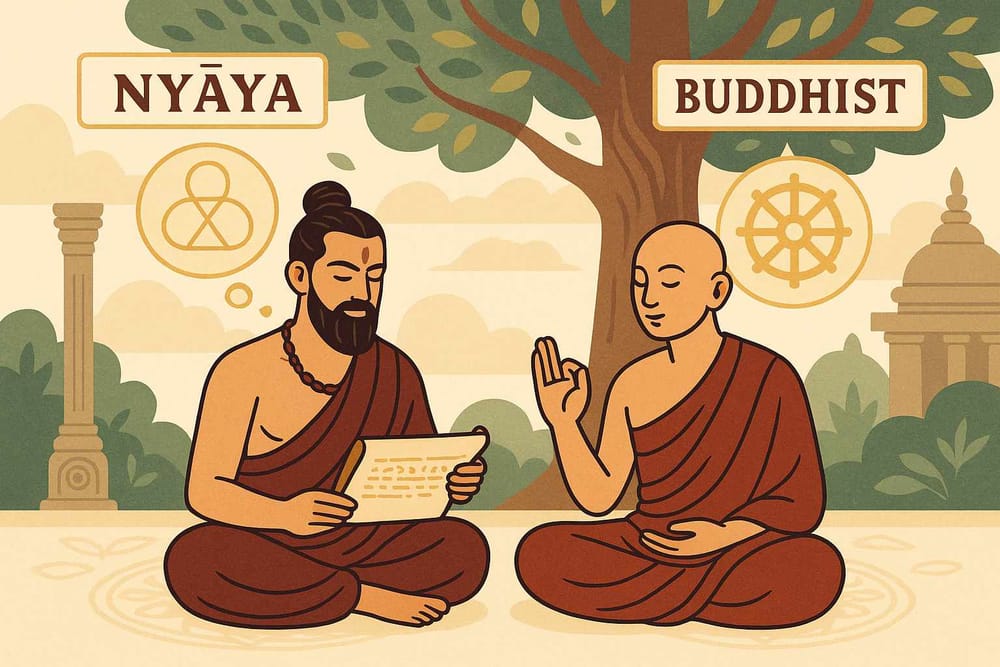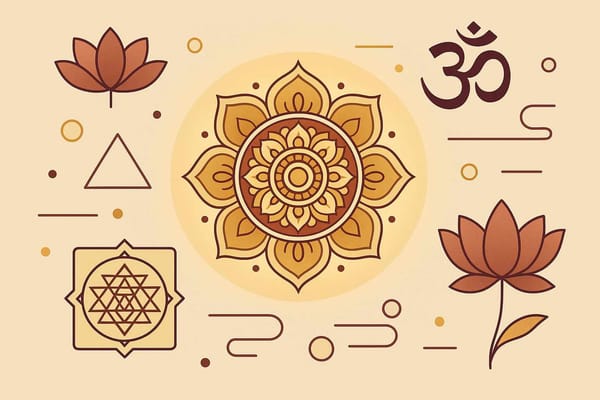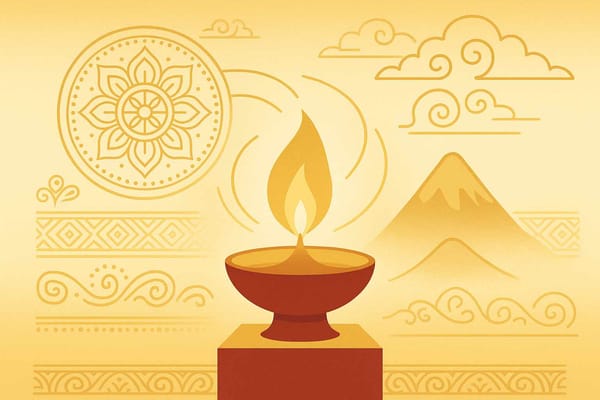
Indian Logic - Nyaya and Buddhist Perspectives: A Deep Dive
Have you ever been in a heartfelt discussion with a friend, trying to explain your point of view with perfect logic? That feeling of wanting to arrive at the truth, to present your case so clearly that it can’t be denied – it’s a deeply human instinct. What if I told you that our ancestors in India elevated this very process into a profound spiritual science? They created incredible systems of reasoning not just to win arguments, but to understand the very nature of reality. Two of the most brilliant paths they carved out were the Nyaya school of Hindu philosophy and the logical traditions within Buddhism.
Though they often debated each other, like two grandmasters in a celestial game of chess, both schools gifted us tools to sharpen our minds and deepen our understanding. Let’s take a gentle walk down these ancient intellectual corridors and see what treasures they hold for us today.
The Nyaya School: Building a Fortress of Reason
The word 'Nyaya' itself means "method" or "rule" in Sanskrit. Think of it as a systematic, step-by-step guide to thinking clearly. It’s one of the six main schools (darshanas) of Hindu philosophy, and its primary goal is to end suffering by attaining valid knowledge. The Nyaya school believes that if we can see the world as it truly is, free from false beliefs, we can find liberation.
The Four Pillars of Knowledge (Pramanas)
So, how do we gain this "valid knowledge"? The Nyaya sages, like the great Akshapada Gautama who wrote the foundational Nyaya Sutras, identified four reliable sources. They called them the Pramanas:
- Pratyaksha (Perception): This is the most direct way of knowing – what you see, hear, touch, taste, and smell. It’s the simple, undeniable experience of the world through your senses, like feeling the warmth of the morning sun on your skin.
- Anumana (Inference): This is the art of logical deduction. If you see smoke rising from a distant hill, you can infer that there is a fire. Nyaya developed a brilliant five-step method for this, ensuring the conclusion is sound and not just a wild guess.
- Upamana (Comparison or Analogy): This is how we learn by relating something new to something we already know. If someone tells you a "gavaya" (a wild ox) is like a cow but wilder, you can identify one when you see it. It’s the beautiful human ability to build bridges of understanding.
- Shabda (Testimony): This is knowledge gained from a trustworthy source, whether it’s a wise expert, a teacher, or sacred scriptures. In our spiritual journey, relying on authentic texts is crucial. This is why, at Bhaktilipi, we are so passionate about preserving and sharing timeless devotional literature in its true essence.
The Nyaya system is incredibly practical. It gives us a framework to test ideas, structure our thoughts, and engage in meaningful dialogue, ensuring that our discussions lead to clarity, not confusion.
Buddhist Logic: A Compass for the Mind's Journey
While Nyaya focused on building a logical system to understand an external, objective world, Buddhist thinkers like Dignaga and Dharmakirti turned logic inward. For them, reasoning was a powerful tool for dismantling illusions about reality and paving the path to enlightenment. Their focus wasn't just on what is true, but on how the mind perceives and often constructs that truth.
Seeing Clearly: The Two Ways of Knowing
Buddhist epistemology simplifies the sources of knowledge to just two Pramanas:
- Perception (Pratyaksha): Similar to Nyaya, this is direct experience. However, Buddhism emphasizes a pure form of perception, one that is free from the concepts and labels our minds usually attach to things. It's about seeing a flower as it is, without the word "flower" or associated memories.
- Inference (Anumana): Logic is used here not just to understand the world, but to grasp core Buddhist teachings like impermanence (Anitya) and the non-existence of a permanent self (Anatman). It's a method to reason your way to wisdom, a key component in the path of knowledge and devotion.
The Power of 'What It Is Not' (Apoha Theory)
One of the most fascinating ideas in Buddhist logic is 'Apoha' or the theory of exclusion. It suggests that a word gets its meaning not by pointing to an essential quality, but by excluding everything else. The word "cow" doesn't capture some eternal "cowness"; it simply means "not a horse, not a goat, not a tree." This brilliant concept reinforces the Buddhist idea that things lack a fixed, independent essence and are in a constant state of flux.
Where the Paths Diverge: A Tale of Two Philosophies
For centuries, the scholars of Nyaya and Buddhist schools were locked in intense, respectful debates. These intellectual battles helped both traditions refine their ideas. Their core differences offer a beautiful glimpse into the diversity of Indian thought.
A key point of discussion was the nature of the self. Nyaya philosophy asserts the existence of an enduring, eternal self (Atman), the knower who perceives the world. Buddhist logic, on the other hand, argues passionately against this, using reason to demonstrate that what we call "self" is just a temporary combination of changing physical and mental processes (Anatman or no-self).
Similarly, Nyaya is a philosophy of realism—it holds that the external world is real and exists independently of our minds. Buddhist thought, particularly in some schools, leans towards nominalism, suggesting that our reality is heavily shaped by our mental constructs and perceptions.
Why This Ancient Wisdom Still Matters Today
You might wonder, "What do these ancient debates have to do with my life today?" The answer is: everything. Learning about Nyaya teaches us how to think critically, to question our assumptions, and to build strong, reason-based arguments. It's a powerful tool for clarity in a world filled with information overload.
Buddhist logic, in turn, invites us to look within. It shows us how our minds work and how we can use reasoning not just for external success, but for inner peace. It helps us understand that applying ancient wisdom is a core part of living a meaningful life, a concept deeply tied to our understanding of Dharma in daily life.
Studying both together reveals a profound truth: the quest for knowledge can take many forms. Whether it's through the structured, world-affirming logic of Nyaya or the introspective, mind-focused reasoning of Buddhism, the goal is always to move from darkness to light, from ignorance to wisdom.
This rich heritage of intellectual and spiritual inquiry is a gift. It encourages us to live thoughtfully, to engage in dialogue with respect, and to never stop seeking the ultimate truths of our existence.
Explore Our Heritage with Bhaktilipi
At Bhaktilipi, we are dedicated to bringing this timeless wisdom to you. Our mission is to be a space where you can explore the profound depths of Indian devotional literature and philosophical stories, reimagined for today's world. We believe that understanding traditions like Nyaya and Buddhist logic can greatly enrich our spiritual journeys.
For more insights and stories that connect you to our culture, we invite you to join our community. Stay updated with our latest devotional content by subscribing to our YouTube channel, following us on Instagram, and connecting with us on Facebook. Let’s explore this path of knowledge together.
A passionate group of people dedicated to preserving India's knowledge of Dharma, Karma, and Bhakti for ourselves and the world 🙏.
Comments
Related in

Exploring the Depths of Indian Logic and Metaphysics - A 2025 Guide
Have you ever looked at the world around you and felt a deep, nagging question bubble up from within? A question about what is truly real, beyond what our eyes can see? This feeling, this curiosity, is not new. It's a sacred inquiry that our ancestors in India

Vyapti and Linga in Indian Logic: A 2025 Guide
Have you ever looked at dark, heavy clouds gathering in the monsoon sky and just known, deep in your bones, that it’s about to rain? Or smelled the sweet, earthy fragrance of wet soil—sondhi mitti—and felt a sense of joy and relief? That certainty, that instinctive connection
